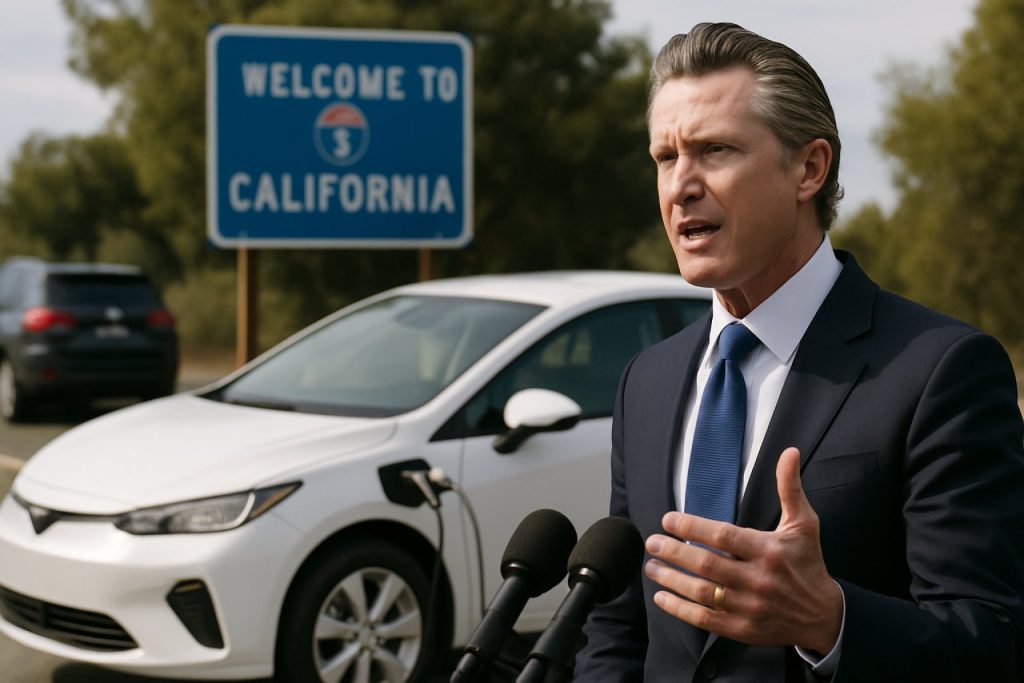
- California sets the nation’s toughest automobile emissions standards, driving progress toward cleaner air and greater climate resilience.
- Through EPA waivers under the Clean Air Act, California can create stricter car pollution rules than the federal government.
- Other states often adopt California’s emissions benchmarks, expanding their influence across the country.
- Critics from energy-producing regions argue California’s standards unfairly shape national policy and economic priorities.
- California’s ambitious goals, like banning sales of new gasoline-powered cars by 2035, encourage auto industry innovation and improved fuel economy nationwide.
- The debate over California’s authority highlights a broader conflict between traditional fossil fuel dependence and pushes for widespread electrification.
- The outcome will impact national vehicle regulations and define how individual states can influence America’s environmental future.
California’s highways have long been a battleground—not just for traffic, but for the future of automobile emissions in America. Towering above the rest, the state has carved a path toward cleaner air with some of the most aggressive environmental standards in the nation. This ambition is etched, quite literally, into the stone at the headquarters of its air regulator: an art installation depicts gasoline pumps, fossilized and abandoned, as a testament to a vision of a post-fossil fuel future.
For over fifty years, federal law has permitted California to set its own car pollution rules, a rare privilege rooted in its infamous smog and the need for creative remedies. Under the Clean Air Act since 1967, California alone has received waivers from the Environmental Protection Agency (EPA) to institute tougher requirements than the federal baseline, leading to cars that sip rather than guzzle gasoline. States grappling with air pollution—New York, Massachusetts, and others—have since echoed California’s standards, pushing automakers to design cleaner fleets nationally.
Yet this permission has bred fierce resentment outside the Golden State, particularly in regions where oil and coal are more than a memory—they’re a lifeblood. Some lawmakers argue that California’s wide influence unfairly tilts national policy, transforming the state into what critics call a “superstate.” The tension came to a head as federal lawmakers moved to retract California’s authority to enforce several new rules targeting emissions from cars, trucks, and electric vehicles.
Opponents of California’s lead, often hailing from energy-producing states, contend that local policies shouldn’t dictate the fate of the entire country’s auto industry or economic future. They see the state’s embrace of electric vehicles and restrictive pollution caps as detached from economic realities elsewhere.
But environmental experts point to a different reality: California’s standards have driven national progress. The state’s aggressive goals—such as phasing out the sale of new gasoline-powered cars by 2035—have nudged the entire auto industry to rethink innovation. Over the past two decades, national fuel economy has improved steadily, partly due to states’ voluntary adoption of California’s benchmarks.
California’s Governor and environmental leaders vow to defend their authority in court, citing a legacy of bold leadership on air quality. The broader debate, however, is about more than legal waivers or regulatory turf. It’s a clash of visions—between a world clinging to fossil fuel tradition and one racing toward electrification and cleaner skies.
The real stakes reach far beyond state lines: The outcome will not only shape the engines that power America but could also determine how much sway any one state can exert over the nation’s path to climate resilience.
For more updates on environmental regulations and climate issues, visit EPA.gov.
Takeaway: The struggle to define America’s vehicle emissions isn’t just about technology or economics—it’s a question of who leads the charge in the race for a cleaner, healthier future.
Why California’s Car Emissions War Could Decide America’s Clean Energy Future (And What You Need to Know Now!)
California’s Role as America’s Auto Emissions Pioneer: Untold Insights
California’s battle to set tougher car emissions standards is not just historic, but transformative—reshaping the auto industry, accelerating clean technologies, and fueling national debates that impact your environment, your car choices, and your wallet. This article delivers critical facts, hidden impacts, practical guides, and insightful expert forecasts beyond the surface narrative.
—
What Makes California’s Emissions Waiver Unique? How Did It Start?
– Historic Smog Crisis: In the 1940s and 1950s, Los Angeles was regularly choked by some of the worst smog levels in history, resulting in health emergencies, and spurring early air quality regulations ([NRDC](https://www.nrdc.org)).
– Pioneering Policies: California’s first-in-the-nation tailpipe emissions law in 1966 led to features like the catalytic converter.
– Legal Design: The Clean Air Act of 1970 granted California the unique power to apply for waivers, setting tougher standards. No other state has such authority, though others can “opt in.”
—
The Ripple Effect: California as the Silent National Auto Regulator
– “California Effect”: Once California sets a tighter standard, automakers often upgrade all U.S.-bound vehicles to meet or exceed them, driving nationwide fuel economy and emissions improvements.
– Nationwide Adoption: As of 2024, 17 states and Washington D.C. have adopted California’s stricter emissions rules—covering roughly 40% of the U.S. auto market ([EPA](https://www.epa.gov)).
– Market Impact: Major automakers, including Ford, GM, and Toyota, design national fleets with California requirements in mind, reducing costs via standardization.
—
How To: Understand California’s Zero-Emission Vehicle (ZEV) Mandate
Step-by-Step:
1. ZEV Mandate Timeline: By 2035, all new cars sold in California must be zero-emission (battery-electric, hydrogen fuel cell, or certain plug-in hybrids).
2. Transitional Credits: Automakers may earn credits for selling ZEVs, encouraging early adoption.
3. Dealer Education: Dealerships receive grants and training to support electric vehicle sales and infrastructure.
Life Hacks:
– Tax Incentives: California EV buyers may qualify for state rebates up to $7,500 (in addition to federal credits), lowering ownership costs dramatically.
– Charging Infrastructure: The state funds thousands of fast chargers statewide—use tools like PlugShare to plan routes.
—
Real-World Uses & Benefits: Cleaner Air, Less Respiratory Disease
– Public Health Gains: Since the 1970s, auto emissions controls in California have cut smog-forming gases by more than 90%, saving thousands of lives annually and reducing hospitalizations for asthma and lung disease ([CDC](https://www.cdc.gov)).
– Consumer Savings: Improved fuel economy under California’s standards has saved families hundreds of dollars per year on average fuel costs.
—
Industry Trends & Forecasts
– Automaker Investments: By 2030, global automakers are expected to invest over $500 billion in EV technology, citing California’s leadership as a key driver ([IEA](https://www.iea.org)).
– EV Market Share: EVs represented over 21% of new car sales in California in 2023, far outpacing the national average (about 7%).
– Sustainability Focus: California’s grid is also rapidly decarbonizing, further reducing the true emissions footprint of EVs compared to gasoline cars.
—
Reviews & Comparisons: California vs. Federal Standards
| Aspect | California Standard | Federal Standard (2024) |
|——————————-|————————————–|——————————-|
| ZEV Sales Mandate | 100% by 2035 | No nationwide ZEV mandate |
| Fleet Emissions Limit | Stricter, lower CO2 per mile | Looser, higher CO2 allowed |
| Consumer Incentives | Generous state rebates & grants | Federal tax credits only |
—
Controversies & Limitations
– Regional Pushback: Oil and coal states argue California’s standards harm their economies and local jobs.
– Legal Uncertainty: Ongoing lawsuits and Congressional proposals could revoke California’s authority, creating a patchwork of rules.
– Charging Access: In some rural areas, EV charging is still sparse, complicating adoption.
– Equity Concerns: Marginalized communities often lack access to new EV tech; California is targeting this with more rebates and infrastructure programs.
—
Security & Sustainability
– Grid Security: California is investing in grid resilience and renewables to ensure EV demands don’t outpace capacity.
– Battery Recycling: New state laws require EV battery recycling standards by 2026, limiting environmental impact.
– Cybersecurity: As cars become more connected, state and federal regulators coordinate on software and data security protocols.
—
Pros & Cons Overview
Pros:
– Healthier air, fewer respiratory diseases.
– Lower fuel and maintenance costs for consumers.
– Rapid innovation and global leadership in clean tech.
Cons:
– Potential higher upfront car prices.
– Infrastructure buildout remains uneven.
– Industry pushback, legal challenges create uncertainty.
—
Most Pressing Reader Questions & Expert Answers
Q1: Will California’s rules force me to give up my gasoline car?
No. The 2035 rule only affects new car sales. Existing gasoline vehicles can still be driven and sold.
Q2: How do California’s updates impact nationwide car prices?
Slightly higher upfront costs are possible, but greater fuel savings and lower maintenance costs can offset this over a vehicle’s life span.
Q3: Will other states lose policy control if California leads?
States remain free to set (or not set) tougher air standards; they can opt in or out per the Clean Air Act.
Q4: Is California’s grid ready for an all-electric future?
While challenges remain, the state is investing heavily in renewables, storage, and grid upgrades to meet rising demand.
—
Actionable Recommendations & Quick Tips
1. Check Eligibility: See if you qualify for state or federal EV incentives before buying.
2. Plan Charging: Use California’s growing public charger network—visit sites like PlugShare.
3. Stay Informed: Monitor upcoming policy shifts at EPA.gov.
4. Advocate: Support local infrastructure improvements and clean vehicle incentives to benefit your community.
5. Educate: If considering a vehicle purchase, review total ownership costs—EVs often offer better long-term value.
—
Bottom Line
California’s car emissions policies are setting the pace for cleaner, healthier air and turbocharging the U.S. auto industry’s shift to clean technology. Legal and political battles may continue, but experts agree: how California moves today will steer the nation’s—and perhaps the world’s—auto future. Take advantage of incentives now, plan for a more electric future, and stay tuned for changes poised to impact everyone on the road.



